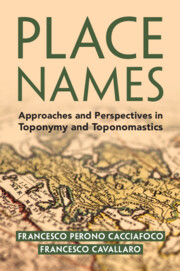Book contents
- Place Names
- Place Names
- Copyright page
- Contents
- Figures
- Tables
- Preface
- Acknowledgements
- 1 Introduction
- 2 Language Change
- 3 Historical Toponomastics
- 4 Toponymy and the Historical-Linguistic Reconstruction of Proto-Languages
- 5 Diachronic Toponymy
- 6 Landscape and Toponymy
- 7 Historical Toponomastics and Historical Geography
- 8 Synchronic Toponymy
- 9 Place Names and Society
- 10 Toponymy and Cartography
- Glossary
- References
- Index
8 - Synchronic Toponymy
Published online by Cambridge University Press: 02 March 2023
- Place Names
- Place Names
- Copyright page
- Contents
- Figures
- Tables
- Preface
- Acknowledgements
- 1 Introduction
- 2 Language Change
- 3 Historical Toponomastics
- 4 Toponymy and the Historical-Linguistic Reconstruction of Proto-Languages
- 5 Diachronic Toponymy
- 6 Landscape and Toponymy
- 7 Historical Toponomastics and Historical Geography
- 8 Synchronic Toponymy
- 9 Place Names and Society
- 10 Toponymy and Cartography
- Glossary
- References
- Index
Summary
This chapter shifts from the historical approaches of studying place names to synchronic toponymy, which deals with place names in a particular moment in time and in a specific area. The synchronic toponymist collects a dataset, or corpus of toponyms, categorises them, and searches for common naming patterns. He/she may also study the semantics and semantic structure of the place names according to the social and political realities of the analysed time period. The major case study in this chapter discusses the naming practices and toponymic classification in Singapore’s public places. It explains how the naming of places and streets, in various stages of the city-state’s history, have been influenced by issues of governmentality and politics, as well as by a sensitivity to its multiethnic population. In the second half of the chapter, the authors focus on critical toponymies, an area of research that has gained traction in recent years. Place names are neither ‘neutral’ nor ‘innocent’, but are brimming with social, political, and cultural meaning and significance. To this end, the authors also explore issues connected with the ‘commodification’ of place names and how toponyms can become tourist attractions.
- Type
- Chapter
- Information
- Place NamesApproaches and Perspectives in Toponymy and Toponomastics, pp. 190 - 220Publisher: Cambridge University PressPrint publication year: 2023



